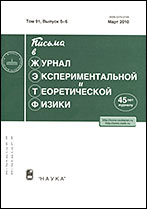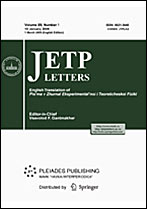|
CONDENSED MATTER
Effect of disorder on magnetotransport in semiconductor artificial graphene
O. A. Tkachenkoa, V. A. Tkachenkoab, D. G. Baksheevb, O. P. Sushkovc
a Rzhanov Institute of Semiconductor Physics, Siberian Branch, Russian Academy of Sciences, Novosibirsk, 630090 Russia
b Novosibirsk State University, Novosibirsk, 630090 Russia
c School of Physics, University of New South Wales, 2052 Sydney, Australia
Abstract:
Magnetotransport in mesoscopic samples with semiconductor artificial graphene has been simulated within the Landauer–Büttiker formalism. Model four-terminal systems in a high-mobility two-dimensional electron gas have a square shape with a side of 3–5 μm, which is filled with a short-period (120 nm) weakly disordered triangular lattice of antidots at the modulation amplitude of the electrostatic potential comparable with the Fermi energy. It has been found that the Hall resistance Rxy(B) in the magnetic field range of B=10–50 mT has a hole plateau Rxy=−R0, where R0=h/2e2=12.9kΩ, at carrier densities in the lattice below the Dirac point n<n1D and an electron plateau Rxy=R0 at n>n1D. Enhanced disorder destroys the plateaus, but a carrier type (electrons or holes) holds. Long-range disorder at low magnetic fields suppresses quantized resistance plateaus much more efficiently than short-range disorder.
Received: 15.11.2022
Revised: 01.12.2022
Accepted: 08.12.2022
Citation:
O. A. Tkachenko, V. A. Tkachenko, D. G. Baksheev, O. P. Sushkov, “Effect of disorder on magnetotransport in semiconductor artificial graphene”, Pis'ma v Zh. Èksper. Teoret. Fiz., 117:3 (2023), 228–234; JETP Letters, 117:3 (2023), 222–227
Linking options:
https://www.mathnet.ru/eng/jetpl6863 https://www.mathnet.ru/eng/jetpl/v117/i3/p228
|


| Statistics & downloads: |
| Abstract page: | 61 | | References: | 21 | | First page: | 9 |
|





 Contact us:
Contact us: Terms of Use
Terms of Use
 Registration to the website
Registration to the website Logotypes
Logotypes









 Citation in format
Citation in format 